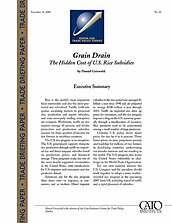Rice is the world’s most important food commodity and also the most protected and subsidized. Tariffs, tariff-rate quotas, escalating barriers to processed rice, production and export subsidies, and state monopoly trading enterprises are common. Worldwide, tariffs on rice imports average 43 percent, and border protection and production subsidies account for three-quarters of income for rice farmers in wealthier countries.
The U.S. rice program is no exception. The U.S. government supports domestic rice production through tariffs on imported rice and direct taxpayer subsidies based on production, prices, and historical acreage. Those programs make rice one of the most heavily supported commodities in the United States, with ramifications for U.S. taxpayers and consumers and rice producers abroad.
Americans pay for the rice program three times over–as taxpayers, as consumers, and as workers. Direct taxpayer subsidies to the rice sector have averaged $1 billion a year since 1998 and are projected to average $700 million a year through 2015. Tariffs on imported rice drive up prices for consumers, and the rice program imposes a drag on the U.S. economy generally through a misallocation of resources. Rice payments tend to be concentrated among a small number of large producers.
Globally, U.S. policy drives down prices for rice by 4 to 6 percent. Those lower prices, in turn, perpetuate poverty and hardship for millions of rice farmers in developing countries, undermining our broader interests and our standing in the world. The U S. program also leaves the United States vulnerable to challenges in the World Trade Organization.
For our own national interest, the U.S. Congress and the president should work together to adopt a more market-oriented rice program in the upcoming 2007 farm bill, including repeal of tariffs and a rapid phaseout of subsidies.

This work is licensed under a Creative Commons Attribution-NonCommercial-ShareAlike 4.0 International License.

